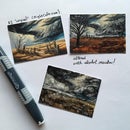Introduction: Box Sculpture101
Box sculpture is a classic art/craft project for children. In this Instructable, I will show some of the many different materials that can be used. There will be plenty of hints and lots of inspiration. Let's get started!
Supplies
For the very simplest, tidiest, minimalist project, you can get by with just three supplies: Boxes. Markers. Glue.
For the ultimate fun project you will want: All of the above, plus scissors, plus as many of these as you can find:
Connectors: hot glue, tape, double-stick tape, paper fasteners, chenille stems, wire, velcro
Things-to-cover-a-box: adhesive-backed vinyl, colored paper, fabric, paint, heavy paper
Details: buttons, screen, hardware, pompoms, wiggle eyes, wooden scraps, chenille stems, small lids, felt scraps, heavy paper
Step 1: Collect Boxes
Be on the lookout for small boxes. If you have room, just toss them into a larger box and bring them out when they are needed. If storage is an issue, "break down" the boxes.
Step 2: Plan Your Design
Once you have enough boxes, line them up to form... um.... something.
Some children will be able to come up with ideas just by looking at a bunch of boxes.
Others may need some samples or prompts.
Robots are one of the simplest and most versatile subjects.
Cities or villages are also fun.
Vehicles are a classic.
Another fun subject: Animals. Realistic or Fantastic.
Aliens, spaceships, and fantasy landscapes are all great.
Step 3: Inside-Out
A box may be the correct size and shape... but you don't want to see the printing on the box.
One solution is take the box apart, turn it inside out, and re-glue it.
Step 4: Re-sizing
Sometimes, you may want to cut an existing box to make it smaller. A toothpaste box can be easily be cut into smaller boxes.
Step 5: Draw
There are MANY ways to decorate the surface of a box. The simplest method is to just use markers.
For this owl, I had two nice white boxes. I cut shapes from heavy paper, glued them on, and added color.
Step 6: Paint
Acrylic paint works great on boxes.
One thing to keep in mind: Glue will probably adhere better to the box than the paint, so you might want to leave the "glue end" free of paint.
Step 7: Cover With Vinyl
Adhesive-backed vinyl is another way to cover a box. Now that cutting machines are popular, vinyl is available in many "Dollar Stores."
As mentioned in step 6, keep the "glue-me" side free of vinyl.
Step 8: Double Stick Tape and Paper
Double-stick tape gives you a neat and tidy way to cover a box. Use it with any kind of paper.
Step 9: Double Stick Tape and Fabric
Light-weight fabrics or plastics can also be attached with double-stick tape. (I buy rolls and rolls of it each year!)
Step 10: Assemble the Boxes
When our boxes are ready to be joined together, there are also many options.
Hot glue is one of the fastest ways to fasten together boxes. Use low temperature glue.
(With groups of children, an adult may be in charge of the hot glue gun.)
Regular glue works, of course. (But sometimes it's hard to wait for the glue to dry.)
If your pieces are small, you might even want to fasten some boxes together with velcro!
Step 11: Add Details
Once the flat surface of the box has been decorated, it's time to add trims.
Paint is fun!
Wiggle Eyes are fun!
Fabric is fun!
Chenille Stems are fun!
Found objects are fun!
Robot I-54 details include eyes made from nails, an S-hook mouth, screen wire grill, and removable felt buttons attached with velcro. It is a fairly simple design.
Step 12: Summing Up
I thought the steps for box sculpture would be fairly straightforward... but there are SO MANY variables!
The flowchart above may be helpful.... or not...
But I had fun making it.
I hope you had fun looking at this Instructable!

Runner Up in the
Crafts For Kids Challenge













